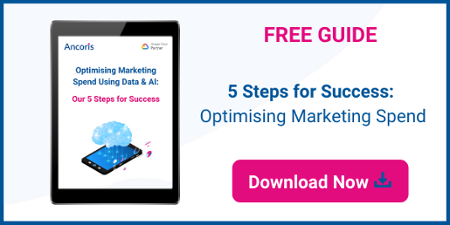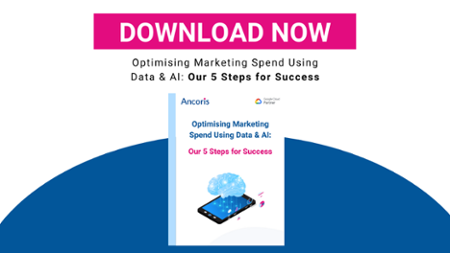The days of launching a marketing campaign on the basis that you think it might work are long gone. Today, everything comes back to data; there needs to be sufficient data in the proposal to back up the hypothesis, and there’s always an appetite for analysing the campaign afterwards to understand its impact.
Historically, marketers have always looked back to look forward: “it worked last year, so we’ll do it this year” has been a common reason for launching a campaign.
But in this article, we’ll show how predictive analytics can help you optimise and improve your processes, relying less on gut-feel and embracing data to look ahead and plan more efficiently, effectively and confidently.
What is predictive analytics in marketing?
Predictive analytics refers to the analysis of data using artificial intelligence (AI) and machine learning to predict future behaviour or trends. In marketing, predictive analytics typically takes historical performance data and trends, alongside transactional data and behavioural data. These data sets are then used to generate insights to forecast future behaviour. Marketers can use the output to plan marketing campaigns, ensuring they’re reaching the right people with the right messages at the right time.
For example, the insights can be used to plan future media buying or forecast campaign success. By understanding what works ahead of time, marketers can make more confident decisions backed by data. This, of course, relies on accurate tracking of campaigns and collection of the right data.
Predictive analytics might be used to deliver accurate product or content recommendations to users based on their purchase history, past behaviour — or even the behaviour of people with similar profiles. It can also be used to segment a customer database depending on their demographic or previous interactions with an organisation.
How can predictive analytics improve your digital marketing?
Knowing what predictive analytics are is one thing, but understanding the benefit of applying it to your marketing efforts is where the real power lies. Using machine learning and data analysis to better predict future outcomes can be helpful in a number of ways.
Here are four ways that predictive analytics can support marketing teams:
1. Show you how to spend your marketing budget
Using historical marketing data and behavioural insights, predictive analytics solutions can help to show how you should spend your marketing dollars. Whether that’s by channel, by time or by campaign, the insight helps marketers and CMOs better understand where success is likely to come from, which helps to shape future campaigns.
2. Improve your marketing ROI
The benefit of being able to better understand profitable marketing channels is that you’re able to spend more wisely, gaining more back for your spend. Marketers always have and always will be judged on the return on investment (ROI) of their campaigns. And while not all campaigns are designed to drive sales, being able to optimise your marketing spend and report back on the return is a powerful tool. Predictive analytics and machine learning can help you to understand the most profitable channels and ensure your campaigns provide the best possible ROI.
3. Understand when a lead is more likely to convert
The key for B2B marketers is to understand the user journey from prospect to lead, and then nurturing the lead to become a potential sale. Predictive analytics can help with this through lead scoring. This is where behaviour of past users is used to more accurately predict when a lead is becoming warmer.
Lead scoring is an automated process where positive actions (such as a marketing email open or reading a piece of content) applies a positive score to your lead. Once the score gets to a certain number, the lead becomes marketing qualified, and can be then passed on to the sales team who will then try to turn the lead into a customer.
4. Improve user experience
User experience is important at all stages of the buyer journey. From attracting prospects through awareness content to nurturing them through the consideration stage until they’re ready to purchase, you need to delight your users every time they interact with your brand.
Predictive analytics can help you do that, by using behavioural data to serve relevant product and/or content recommendations to your users. For example, a recommendation engine can provide product recommendations to customers based on what other customers fitting the same profile have purchased, or recommend content based on previous content consumption.
Should you use predictive analytics tools to improve your marketing strategy?
As a marketer, you don’t want to spend a lot of time buried in spreadsheets and drowning in data. Analysing data is useful, but it’s how you use it and make sense of it that matters, not the process of getting there. Using predictive analytics can streamline and automate that process and remove the headaches from your analysis.
By embracing data, you can improve sales by up to 30%* — something that CMOs will relish being able to report back to CEOs and CFOs.
To better understand how data, AI and predictive analytics can help boost your marketing efforts, download our free whitepaper, Optimising Marketing Spend Using Data & AI: Our 5 Steps for Success.
One thing to remember is that it’s predictive, rather than prescriptive. Use the insights as a guide but also monitor campaigns in real time to understand performance. There are always anomalies that can throw the predictions off kilter slightly; think of how an unseasonably hot day or inclement weather can change people’s behaviour. And who would have foreseen a global pandemic and its impacts on consumer behaviour?
Still, having data-backed campaigns in place allows for more time for adjustment and agility.
Embrace predictive analytics with Ancoris CMOLab
Predictive analytics can be a total game changer for your marketing campaigns. However, it can be difficult to get to grips with the solutions available and understand the best course of action to be able to start harnessing the power of predictive analytics data.
That’s where Ancoris CMOLab comes in. This powerful solution is powered by the Google Cloud Platform and centralises data across the entire customer journey, merging insights from various sources to provide a single customer view. This helps you to visualise key metrics, gain valuable insights and better plan for the future.
See how we helped QiH streamline their reporting and apply modern data analysis techniques to better predict future outcomes:
Are you ready to harness predictive analytics to improve your marketing efforts? Contact Ancoris today to see how we can help you to build better, more accurate marketing campaigns.
Sources
- Experian Data Quality/MIT's Centre for Digital Business


